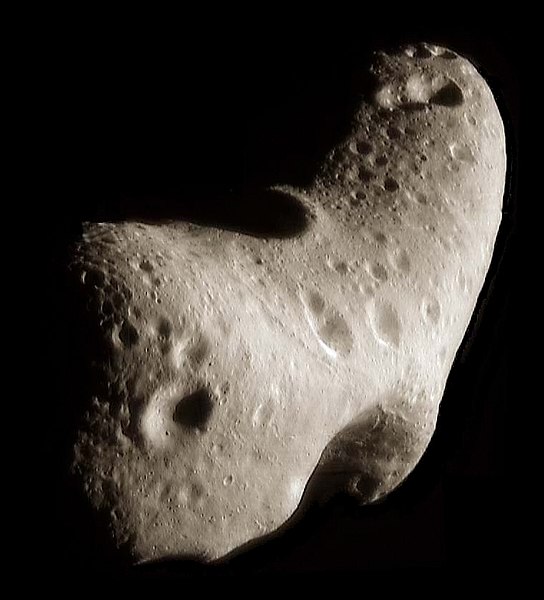Asteroids are small, rocky objects that orbit the Sun. They are typically smaller than planets but larger than meteoroids, ranging in size from a few meters to hundreds of kilometers in diameter. Most asteroids are found in the asteroid belt, a region of the solar system between the orbits of Mars and Jupiter, but they can also be found in other parts of the solar system.
Asteroids are believed to be remnants from the early solar system, and studying them can provide important insights into the formation and evolution of the solar system. Many asteroids are composed of a mix of rock and metal, and some may contain valuable minerals or other resources that could be useful in future space exploration.
Some asteroids have highly elliptical orbits that take them close to the Earth, and there is a small risk that an asteroid could collide with the Earth and cause significant damage. In recent years, efforts have been underway to detect and track potentially hazardous asteroids and develop strategies for deflecting them if necessary.
In addition to being important objects of study for astronomers, asteroids are also of interest for space exploration and commercial ventures. Several spacecraft have been sent to study asteroids up close, including NASA’s Dawn mission to the asteroid Vesta and the asteroid belt, and the Japanese Hayabusa missions to asteroids Itokawa and Ryugu, which returned samples to Earth for study.
How close are the nearest asteroids?
The distance between the Earth and asteroids can vary greatly depending on the current position of the asteroid in its orbit. However, there are several asteroids that come relatively close to the Earth, including:
433 Eros:
This asteroid is one of the largest near-Earth asteroids and has a diameter of approximately 16 kilometers. It has a highly elliptical orbit that takes it as close as 22.4 million kilometers (13.9 million miles) to the Earth.
3200 Phaethon:
This asteroid is the parent body of the Geminid meteor shower and is believed to be a “rock comet” that sheds dust and debris as it orbits the Sun. It has a highly elliptical orbit that takes it as close as 6.4 million kilometers (4 million miles) to the Earth.
2021 GW4:
This is a relatively small asteroid with an estimated diameter of 7-15 meters (23-49 feet). It was discovered in April 2021 and made a close approach to the Earth in April 2021, passing within approximately 16,000 kilometers (10,000 miles) of our planet.
While these asteroids may be relatively close to the Earth in astronomical terms, they are still very far away, with distances measured in millions of kilometers or miles. Nonetheless, ongoing efforts to detect and track potentially hazardous asteroids are important for our understanding of the solar system and for protecting the Earth from potential impacts.
Could asteroids wipe the Earth out?
Asteroids have the potential to cause significant damage if they were to collide with the Earth, but the likelihood of a catastrophic impact large enough to “wipe out” all life on the planet is relatively small.
The most famous example of an asteroid impact is the one that occurred approximately 66 million years ago, which is believed to have led to the extinction of the dinosaurs and many other species. That impact was caused by an asteroid estimated to be around 10 to 15 kilometers (6 to 9 miles) in diameter, and it released an enormous amount of energy, causing widespread destruction and long-term environmental changes.
While the risk of a similarly catastrophic asteroid impact is low, it is still a concern, and efforts are underway to detect and track potentially hazardous asteroids and develop strategies for deflecting them if necessary. The vast majority of asteroids that could potentially impact the Earth are relatively small and would not pose a significant threat to human civilization, but larger asteroids are still a concern.
To mitigate the risk of an asteroid impact, astronomers are actively searching for near-Earth objects (NEOs) and tracking their orbits to determine if they pose a potential threat. If an asteroid were discovered to be on a collision course with the Earth, there are several strategies that could be employed to deflect it, including using spacecraft to impact the asteroid, applying a gravitational tug, or using a nuclear explosion to change its trajectory. However, none of these methods have been tested on an actual asteroid, and further research and testing would be necessary to determine their effectiveness.
What type of effects would an asteroid collision have on Earth?
The effects of an asteroid collision with the Earth would depend on several factors, such as the size, speed, and composition of the asteroid, as well as the location of impact. However, in general, a large asteroid impact could have significant and wide-ranging effects on the environment and human civilization.
If the asteroid is large enough, the impact could create a massive explosion, releasing a tremendous amount of energy in the form of heat, light, and shock waves. The impact could also trigger earthquakes, tsunamis, and volcanic eruptions, causing widespread destruction and loss of life.
In addition to the immediate effects of the impact, the dust and debris kicked up by the collision could block out the sun for an extended period, leading to a “nuclear winter” effect with lower temperatures and reduced sunlight that could last for years or even decades. This could have serious consequences for agriculture and food production, as well as for ecosystems and biodiversity.
Overall, the effects of an asteroid collision would be devastating, and while the likelihood of such an event is relatively low, efforts to detect and track potentially hazardous asteroids are important for our understanding of the solar system and for protecting the Earth from potential impacts.
What is the probability that an asteroid destroys Earth?
The probability of an asteroid destroying the Earth is very low, but it is not zero. The likelihood of a catastrophic impact that could cause the extinction of all life on the planet is estimated to be about once every several million years.
There are two main factors that determine the probability of an asteroid impact: the frequency of asteroid impacts and the size of the asteroids that could cause significant damage. Smaller asteroids, which are more common, would not be able to destroy the Earth but could still cause significant damage and loss of life if they were to collide with a populated area.
The risk of a catastrophic asteroid impact is taken seriously by scientists and policymakers, and efforts are underway to detect and track potentially hazardous asteroids and develop strategies for deflecting them if necessary. The vast majority of asteroids that could potentially impact the Earth are relatively small and would not pose a significant threat to human civilization, but larger asteroids are still a concern.
To mitigate the risk of an asteroid impact, astronomers are actively searching for near-Earth objects (NEOs) and tracking their orbits to determine if they pose a potential threat. If an asteroid were discovered to be on a collision course with the Earth, there are several strategies that could be employed to deflect it, including using spacecraft to impact the asteroid, applying a gravitational tug, or using a nuclear explosion to change its trajectory. However, none of these methods have been tested on an actual asteroid, and further research and testing would be necessary to determine their effectiveness.

